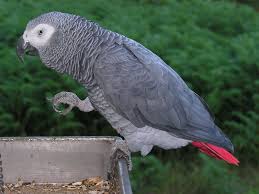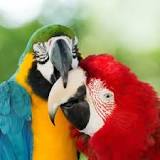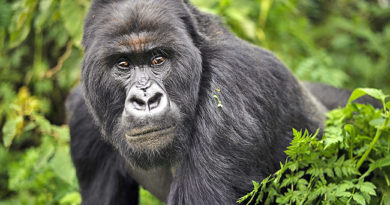SCI-TECH-ORNITHOLOGY: African grey parrots
A new study has found that African grey parrots volunteer assistance to both their good friends and mere acquaintances — even when there is no expectation of personal gain
.
.

Acting selflessly to help others in need was long thought to be a trait confined to mammals, in particular humans and some great ape species like bonobos and orangutans.
But a new study has found that African grey parrots volunteer assistance to both their good friends and mere acquaintances — even when there is no expectation of personal gain.
The paper, published in the journal Current Biology on Thursday, advances our knowledge of the evolution of cooperation and social intelligence, co-author Auguste von Bayern of the Max Planck Institute for Ornithology in Starnberg, Germany told AFP.
.

African grey parrots
.
BELOW IS RESERVE FOR YOUR ADVERTISEMENT –

Both parrots and corvids (like crows and ravens) are renowned for their extraordinary problem solving skills, and are sometimes called “feathered apes.”
Alex, the famous Harvard-based African grey parrot who died in 2007, developed a vocabulary of over 100 words, could identify colors and quantify objects up to the number six, among many other accomplishments.
But despite their impressive intelligence, earlier experiments have failed to show crows helping other crows — leading von Bayern and first author Desiree Brucks of ETH Zurich to wonder whether the same was true of parrots.
Working at the Loro Parque research station on the Spanish island of Tenerife, they placed pairs of grey parrots and blue-headed macaws in boxes alongside each other with an transfer hole between the two, and a hole facing a human experimenter that was either kept open or closed.
Both parrot species quickly learned that they could exchange tokens with the experimenter for a nut treat — but only the grey parrots helped their neighbors when their own hole facing the scientist was closed, preventing them from gaining any personal reward.
In the very first round, seven out of eight grey parrots were willing to transfer tokens in their possession to their neighbors so that their friends could feast when they could not.
The fact they did so without knowing they would later be tested in the other role showed that those giving were not expecting the favor to be reciprocated, said von Bayern.
Significantly, the grey parrots appeared to understand the nature of the task, as opposed to acting out of playfulness. When they saw the other parrot had an opportunity for exchange, they’d pass a token over — but otherwise, they would not.

African grey parrots
.
BELOW IS RESERVE FOR YOUR ADVERTISEMENT –

.
– Lending a wing –
And, like humans, the grey parrots appeared to favor their friends, sharing more tokens with birds they had previously closely associated with, though they still gave some to acquaintances.
The experimenters did not test whether the effect would occur with perfect strangers.
It is not fully clear why the grey parrots acted “prosocially” while the macaws did not, but the researchers suggest it may be linked to how the two species organize themselves in the wild.
African greys live in huge flocks of up to 1,200 birds, Brucks told AFP, and this may require greater social cognitive abilities than macaws that live in much smaller groups of 10 to 30 individuals.
The team would now like to investigate how widespread cooperation is among the world’s 393 parrot species and examine what evolutionary pressures led to it.
They’d also like to learn whether the birds are acting out of genuine empathy and if the level of help given is proportionate to the need of the recipient — for example, will a parrot who just had a meal receive the same level of assistance as one which is hungry?
.
.
BELOW IS RESERVE FOR YOUR ADVERTISEMENT –

.
– No jealousy –
The latest research builds on previous work exploring grey parrots’ concern for the wellbeing of others.
In a study published in the journal Royal Society Open Science in December involving the same scientists and others, researchers gave the birds two types of token: one which rewarded just the subject, and another that provided food to both the subject and its neighbor.
At first they chose randomly — but when the parrots were tested alternatingly with their neighbor, they learned to choose the token that benefitted both birds.
What’s more, a third paper published in Scientific Reports in November found that the parrots do not show signs of jealousy if a partner receives a better reward for the same work, unlike primates (including humans).
“At first, this finding came as a surprise, given that a ‘sense of fairness’ is considered a prerequisite for the evolution of cooperation,” said von Bayern, to prevent a breakdown of ties.
But one possible explanation could be the species’ penchant for monogamy, as opposed to primates who switch partners as new opportunities arise.
“Given that parrots are so closely bonded with a single individual and thus so mutually interdependent, it does not make any difference if one of them gets a better pay-off once in a while,” said Von Bayern.
“What counts is that together, they function as a unit that can achieve much more than each of them on their own.”
BELOW IS RESERVE FOR YOUR ADVERTISEMENT –

.
.
Facts About African Grey Parrots
If you’ve ever seen an African Grey parrot, then you know that they are beautiful birds, but did you also know that they are capable of amassing vocabularies of up to 1,000 words or more, and using the words that they learn to speak in context? To say that these birds are intelligent would be an understatement, and the best part is, that’s not the only thing that makes the African Grey parrot so special. Read on to discover a few of the most interesting and exciting facts about African Grey parrots, including their origin, information on the various subspecies of African Grey, and more. Learning more about these incredible birds may inspire you to get involved with the species in a larger capacity, be it through adoption, research, or conservation.
BELOW IS RESERVE FOR YOUR ADVERTISEMENT –

.
-
:max_bytes(150000):strip_icc():format(webp)/african-grey-parrot--psittacus-erithacus--captive-121805814-5b4bf98346e0fb003790af41.jpg)
Enrique R. Aguirre Aves / Getty Images While all types of African grey parrots look similar, there are two distinct types and a couple of lesser-known subspecies of this beloved bird. The most popular and common is the Congo African grey. The Congo African grey is the largest of the African grey parrots, sporting a lighter gray color in its plumage, and a solid black beak. The second most common type is the Timneh African grey, which was recognized as a species in and of itself in 2012. The Timneh African grey is slightly smaller than the Congo, and its feathers are darker in color. Another defining characteristic of the Timneh grey is that it has a horn-colored upper mandible instead of a black one. Despite their differences, both of these types of African grey parrots make excellent pets, and both are equally intelligent. upper mandible instead of a black one. Despite their differences, both of these types of African grey parrots make excellent pets, and both are equally intelligent.
BELOW IS RESERVE FOR YOUR ADVERTISEMENT –

.
-
:max_bytes(150000):strip_icc():format(webp)/parrot-664908564-5ace880b3de42300376b2872.jpg)
Passakorn_14 / Getty Images Besides being one of the most popular pet bird species, African grey parrots are also one of the most intelligent. In recent years, much research has been done on the mental capacity of African grey parrots by scientists around the world. The most famous instance of this is the work that Dr. Irene Pepperberg conducted with her famous African grey, Alex. Using Alex and other African greys in research trials focusing on communication, she was able to show that not only can African grey parrots learn an incredible amount of human words, they can learn to use them in context to communicate with their owners. It has been said that these impressive birds have the mental and emotional capacities of a 5-year-old human child.
BELOW IS RESERVE FOR YOUR ADVERTISEMENT –

.
-
:max_bytes(150000):strip_icc():format(webp)/african-grey-parrot-939542898-5ace871bae9ab800382b7739.jpg)
Adrian Bysiak / Getty Images BELOW IS RESERVE FOR YOUR ADVERTISEMENT –

.
Because they are so intelligent, African grey parrots form very strong bonds with their owners and can be quite emotionally needy. Due to this trait, they do best with owners who can devote ample time to handling and socializing with them daily. Also, African grey parrots need a lot of exercise to keep their strong muscles toned and maintain an adequate physical condition. This means that they must be able to spend several hours per day outside of their cages, playing in supervised, “parrot proof” areas.
-
:max_bytes(150000):strip_icc():format(webp)/african-grey-parrot--psittacus-erithacus--660732946-5ace88743128340036b1a747.jpg)
Waldemar Seehagen / Getty Images .
BELOW IS RESERVE FOR YOUR ADVERTISEMENT –

.
African grey parrots have been known to live for up to 80 years in captivity, so it’s imperative that those who adopt them can commit to a lifetime of living with a bird. African grey parrots are too emotionally sensitive to be able to handle being bounced from owner to owner, but sadly many of them do have several homes throughout their lifetimes because people rush into adopting them without fully thinking it through. You can help put an end to situations like these by helping to educate people about African grey ownership, and by making sure that you set a good example for bird owners who might be interested in adopting such a parrot.
-
:max_bytes(150000):strip_icc():format(webp)/grey-parrot-930491916-5ace87883de42300376b1c6c.jpg)
JanJKlos / Getty Images Most people can relate to the difficulties of keeping a young child occupied, so it’s not a stretch to say that keeping a highly intelligent bird from getting bored can be similar. African grey parrots need plenty of mental stimulation to stay happy and healthy, so they must be provided with a variety of toys and other ways to exercise their minds. Otherwise, they can resort to destructive behavior and develop unpleasant habits that might require professional intervention.
BELOW IS RESERVE FOR YOUR ADVERTISEMENT –

.
.
BELOW IS RESERVE FOR YOUR ADVERTISEMENT –

.
TRIVIA:

Etymology
The word “ornithology” comes from the late 16th-century Latin ornithologia meaning “bird science” from the Greek ὄρνις ornis (“bird”) and λόγος logos (“theory, science, thought”).[5]
History
The history of ornithology largely reflects the trends in the history of biology, as well as many other scientific disciplines, including ecology, anatomy, physiology, paleontology, and more recently, molecular biology. Trends include the move from mere descriptions to the identification of patterns, thus towards elucidating the processes that produce these patterns.
.
BELOW IS RESERVE FOR YOUR ADVERTISEMENT –

.
All photographs, news, editorials, opinions, information, data, others have been taken from the Internet ..aseanews.net | [email protected] | For comments, Email to : The Scientist | Contributor


:max_bytes(150000):strip_icc():format(webp)/GettyImages-594182067-58a6e96d5f9b58a3c918ff67.jpg)
:max_bytes(150000):strip_icc():format(webp)/cropped-hand-reaching-towards-scarlet-macaw-674244983-5b53f5f646e0fb003752dcaf.jpg)
:max_bytes(150000):strip_icc():format(webp)/cropped-hand-feeding-female-eclectus-parrot-688062317-5b4c171346e0fb00379f0216.jpg)
:max_bytes(150000):strip_icc():format(webp)/blue-and-yellow-macaws--ara-ararauna---pair--native-to-south-america--captive--wachenheim--germany-999155090-5b4d121dc9e77c00549c58fd.jpg)
:max_bytes(150000):strip_icc():format(webp)/top-talking-bird-species-390534-final-40d5b22f8c3c4c97aa5afd22f0f89331.png)
:max_bytes(150000):strip_icc():format(webp)/sun-parakeets-135559243-5b53f406c9e77c0037e36d6b.jpg)
:max_bytes(150000):strip_icc():format(webp)/parakeet-97839520-5b4d67f9c9e77c003725a47b.jpg)
:max_bytes(150000):strip_icc():format(webp)/military-macaw-cracking-nut-825528034-5b5e3bb646e0fb0082545dd5.jpg)
:max_bytes(150000):strip_icc():format(webp)/african-grey-parrot--psittacus-erithacus--captive-121805814-5b4bf98346e0fb003790af41.jpg)
:max_bytes(150000):strip_icc():format(webp)/GettyImages-479349637-58a6f1033df78c345b62df59.jpg)
:max_bytes(150000):strip_icc():format(webp)/macaw-149598517-5b550057c9e77c0037bc1c66.jpg)
:max_bytes(150000):strip_icc():format(webp)/close-up-of-african-grey-parrot-in-birdcage-594409955-5b4c144946e0fb0037a6b51f.jpg)
:max_bytes(150000):strip_icc():format(webp)/budgerigar-in-cage-592259185-5b4c1304c9e77c003761e5dd.jpg)
:max_bytes(150000):strip_icc():format(webp)/116033966-58a6e38e5f9b58a3c91827ff.jpg)
:max_bytes(150000):strip_icc():format(webp)/close-up-of-a-macaw---blue---gold-172205799-5b5bd49ac9e77c002573344f.jpg)
:max_bytes(150000):strip_icc():format(webp)/hyacinth-macaw--anodorhynchus-hyacinthinus---adult-in-a-tree--pantanal--mato-grosso--brazil--south-america-533786668-5b4d00cfc9e77c0037156375.jpg)







